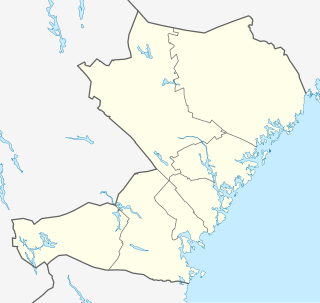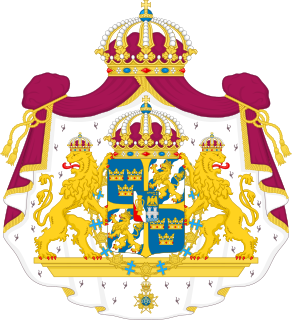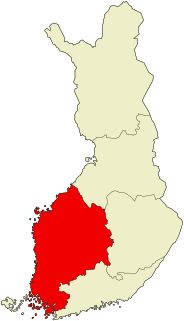The politics of Finland take place within the framework of a parliamentary representative democracy. Finland is a republic whose head of state is President Sauli Niinistö, who leads the nation's foreign policy and is the supreme commander of the Finnish Defence Forces. Finland's head of government is the Prime Minister, who leads the nation's executive branch, called the Finnish Government. Legislative power is vested in the Parliament of Finland, and the Government has limited rights to amend or extend legislation. Because the Constitution of Finland vests power to both the President and Government, the President has veto power over parliamentary decisions, although this power can be overruled by a majority vote in the Parliament.

Västernorrland County is a county (län) in the north of Sweden. It is bordered by the counties of Gävleborg, Jämtland, Västerbotten and the Gulf of Bothnia.

The counties of Sweden are the top-level geographic subdivisions of Sweden. Sweden is today divided into 21 counties; however, the numbers of counties has varied over time, due to territorial gains/losses and to divisions and/or mergers of existing counties. This level of administrative unit was first established in the 1634 Instrument of Government on Lord Chancellor Count Axel Oxenstierna's initiative, and superseded the historical provinces of Sweden in order to introduce a more efficient administration of the realm. At that time, they were what the translation of län into English literally means: fiefdoms. The county borders often follow the provincial borders, but the Crown often chose to make slight relocations to suit its purposes.
Between 1634 and 2009, Finland was administered as several provinces. Finland had always been a unitary state: the provincial authorities were part of the central government's executive branch and the provinces had little autonomy. There were never any elected provincial parliaments in continental Finland. The system was initially created in 1634. Its makeup was changed drastically in 1997, when the number of the provinces was reduced from twelve to six. This effectively made them purely administrative units, as linguistic and cultural boundaries no longer followed the borders of the provinces. The provinces were eventually abolished at the end of 2009. Consequently, different ministries may subdivide their areal organization differently. Besides the former provinces, the municipalities of Finland form the fundamental subdivisions of the country. In current use are the regions of Finland, a smaller subdivision where some pre-1997 läänis are split into multiple regions. Åland islands retain their special autonomous status and their own regional parliament.

Western Finland was a province of Finland from 1997 to 2009. It bordered the provinces of Oulu, Eastern Finland and Southern Finland. It also bordered the Gulf of Bothnia towards Åland.

Southern Finland was a province of Finland from 1997 to 2009. It bordered the provinces of Western Finland and Eastern Finland. It also bordered the Gulf of Finland and Russia.
ISO 3166-2:FI is the entry for Finland in ISO 3166-2, part of the ISO 3166 standard published by the International Organization for Standardization (ISO), which defines codes for the names of the principal subdivisions of all countries coded in ISO 3166-1.

Under the Constitution of Finland, everyone is entitled to have their case heard by a court or an authority appropriately and without undue delay. This is achieved through the judicial system of Finland.

Volta Region, is one of Ghana's ten administrative regions, with Ho designated as its capital. It is located west of Republic of Togo and to the east of Lake Volta. Divided into 25 administrative districts, the region is multi-ethnic and multilingual, including groups such as the Ewe, the Guan, and the Akan peoples. The Guan peoples include the Lolobi, Likpe, Akpafu, Buem, and Nkonya people, et al.
As of 2017, Finland is divided into:

The Finnish Transport Infrastructure Agency, shortened to FTIA, is a Finnish government agency responsible for the maintenance of Finland's road, rail, and waterway systems. The agency's annual budget is 1.6 billion euros. The FTIA's parent organization is the Ministry of Transport and Communications.

An administrative court is a type of court specializing in administrative law, particularly disputes concerning the exercise of public power. Their role is to ascertain that official acts are consistent with the law. Such courts are considered separate from general courts.
The Regional State Administrative Agencies are a set of top-level regional organs of the state of Finland, mainly in charge of basic public services and legal permits. Six agencies took over some of the tasks of the earlier provinces of Finland, which were abolished at the end of 2009. A seventh agency in the autonomous Åland Islands is named the State Department of Åland.
The Northern Finland Regional State Administrative Agency is one of the six Regional State Administrative Agencies. The responsibility area of the agency consists of two regions, nine sub-regions and 43 municipalities.
The Regional State Administrative Agency for Western and Inland Finland is one of the six Regional State Administrative Agencies in Finland. The responsibility area of the agency is composed of five regions, 25 districts and 115 municipalities.
The Regional State Administrative Agency for Southwestern Finland is one of the six Regional State Administrative Agencies. The administrative area of the agency consists of two regions, 9 districts and 77 municipalities.
The Southern Finland Regional State Administrative Agency is one of the six Regional State Administrative Agencies. Its administrative area consists of five regions, 16 sub-regions, and 88 municipalities.
The State Department of Åland is a department of the Finnish central government for the administration of the Åland Islands, with a status corresponding to a Regional State Administrative Agency elsewhere in Finland. It replaced the Åland State Provincial Office on 1 January 2010, after the abolition of all provinces of Finland at the end of 2009.








